
इंडोनेशिया के 'योग्यकर्ता ' शहर से लगभग १८ कि.मी. पर बसा ये एक प्राचीन हिंदू शिवालय है .
इसका निर्माण सन ८५० में संजय वंश के महान राजा 'बलितुंग महा शम्भू ' ने किया था .उस समय इस मंदिर को 'शिव
ग्रह' कहा जाता था .
बुद्धिस्ट शैलेंद्र वंश के विनाश के बाद ,जावा द्वीप में शैव हिंदू 'संजय' वंश की सत्ता प्रस्थापित हुयी ,इन मंदिरों का निर्माण उस समय के हिन्दुओ के वैभवशाली राजसत्ता का चिन्ह मात्र है ,जो स्पष्ट रूप से दर्शाता है की "जहा हिंदू सत्ता है, वहां वैभव है "
समय आज भी प्रतीक्षारत है ,ऐसे अनेको मंदिरों का निर्माण करनेवाली शक्तिशाली हिंदू राष्ट्र की महासत्ता का ........जो की पूर्ण रूप से हम हिन्दुओ की स्वार्थबुद्धि और भ्रामकता में दबी हुयी .........!
Candi Prambanan or Candi Rara Jonggrang is a 9th-centuryHindu temple compound in Central Java, Indonesia, dedicated to the Trimurti, the expression of God as the Creator (Brahma), the Sustainer (Vishnu) and the Destroyer (Shiva). The temple compound is located approximately 18 kilometres (11 mi) east of the city of Yogyakarta on the boundary between Central Java andYogyakarta provinces.[1]
The temple, a UNESCO World Heritage Site, is the largest Hindu temple in Indonesia, and is one of the largest Hindu temples in Southeast Asia. It is characterized by its tall and pointed architecture, typical of Hindu temple architecture, and by the towering 47-metre-high (154 ft) central building inside a large complex of individual temples.[2] One of the most majestic temples in Southeast Asia, Prambanan attracts many visitors from across the world.[3]
Contents[hide] |
[edit]History
History
[edit]Construction
Construction
Prambanan is the largest Hindu temple of ancient Java, and the construction of this royal temple was probably started by Rakai Pikatan as the Hindu Sanjaya Dynasty's answer to the Buddhist Sailendra Dynasty's Borobudurand Sewu temples nearby. Historians suggest that the construction of Prambanan probably was meant to mark the return of the Hindu Sanjaya Dynasty to power in Central Java after almost a century of Buddhist Sailendra Dynasty domination. Nevertheless, the construction of this massive Hindu temple signifies that the Medang court had shifted the focus of its patronage from Mahayana Buddhism to Shivaist Hinduism.
A temple was first built at the site around 850 CE by Rakai Pikatan and expanded extensively by King Lokapala and Balitung Maha Sambu theSanjaya king of the Mataram Kingdom. According to the Shivagrha inscription of 856 CE, the temple was built to honor Lord Shiva and its original name was Shiva-grha (the House of Shiva) or Shiva-laya (the Realm of Shiva).[4] According to Shivagrha inscription, a public water project to change the course of a river near Shivagrha Temple was conducted during the construction of the temple. The river, identified as the Opak River, now runs north to south on the western side of the Prambanan temple compound. Historians suggest that originally the river was curved further to east and was deemed too near to the main temple. The project was done by cutting the river along a north to south axis along the outer wall of the Shivagrha Temple compound. The former river course was filled in and made level to create a wider space for the temple expansion, the space for rows of pervara (complementary) temples.
Some archaeologists propose that the statue of Shiva in the garbhagriha (central chamber) of the main temple was modelled after King Balitung, serving as a depiction of his deified self after death.[5] The present namePrambanan, was derived from the name of Prambanan village where the temple stood, this name probably being the corrupted Javanese pronunciation of "Para Brahman" ("of the brahmins"), doubtless an echo its heyday when the temple was filled with great numbers of brahmins.
The temple compound was expanded by successive Mataram kings such as Daksa and Tulodong with the addition of hundreds of perwara temples around the chief temple. Prambanan served as the royal temple of the Kingdom of Mataram, with most of the state's religious ceremonies and sacrifices being conducted there. At the height of kingdom, scholars estimate that hundreds of brahmins with their disciples lived within the outer wall of the temple compound. The urban center and the court of Mataram were located nearby, somewhere in the Prambanan Plain.
[edit]Abandonment
Abandonment
In the 930s, the court was shifted to East Java by Mpu Sindok, who established the Isyana Dynasty. An eruption of Mount Merapi volcano, located north of Prambanan in central Java, or a power struggle probably caused the shift. That marked the beginning of the decline of the temple. It was soon abandoned and began to deteriorate.
The temples themselves collapsed during a major earthquake in the 16th century. Although the temple ceased to be an important center of worship, the ruins scattered around the area were still recognizable and known to the local Javanese people in later times. The statues and the ruins become the theme and the inspiration for the Loro Jonggrang folktale. After the division of Mataram Sultanate in 1755, the temple ruins and the Opak River were used to demarcate the boundary between Yogyakarta and Surakarta (Solo) Sultanates.
[edit]Rediscovery
Rediscovery
The Javanese locals in the surrounding villages were aware of the temple's existence already before rediscovery. However, they didn't know about its historical background: which kingdoms ruled or which king commissioned the construction of the monuments. As a result, the locals developed tales and legends trying to explain the origin of temples, infused with myths of giants, a cursed princess, and thus gave Prambanan and Sewu a wondorous origin said to be created by multitude of demons under the order of Bandung Bondowoso, according to Loro Jonggrang legend.
The temple officially caught the international attention in early 19th century. In 1811 during Britain’s short-lived rule of the Dutch East Indies, Colin Mackenzie, a surveyor in the service of Sir Thomas Stamford Raffles, came upon the temples by chance. Although Sir Thomas subsequently commissioned a full survey of the ruins, they remained neglected for decades, with Dutch residents carting off sculptures as garden ornaments and native villagers using the foundation stones for construction material.
Half-hearted excavations by archaeologists in the 1880s merely facilitated looting. Reconstruction of the compound began in 1918, and proper restoration only in 1930. Efforts at restoration continue to this day. The reconstruction of the main Shiva temple was completed around 1953 and inaugurated by Sukarno. Since much of the original stonework has been stolen and reused at remote construction sites, restoration was hampered considerably. Shrines were only rebuilt if at least 75% of their original masonry was available. Most of the smaller shrines are therefore now only visible in their foundations, with no plans for their reconstruction existing.
[edit]Contemporary events
Contemporary events
In the early 1990s the government removed the market that had sprung up near the temple and transformed the surrounding villages and rice paddies into an archaeological park. The park covers a large area, from Yogyakarta-Solo main road in the south, encompassing the whole Prambanan complex, the ruins of Lumbung and Bubrah temples, and as far as the Sewu temple compound in the north. In 1992 the Indonesian government created a State-owned Limited Liability Enterprise (PERSERO) of PT Taman Wisata Candi Borobudur, Prambanan, dan Ratu Boko. This enterprise is the authority for the park management of Borobudur Prambanan Ratu Boko and the surrounding region. Prambanan is one of the most visited tourist attraction in Indonesia.
The open-air and indoor stages on the west side of the temple right across the Opak river, were built to stage the Ramayana ballet. This traditional Javanese dance is the centuries old dance of the Javanese court, performed every full moon night in the Prambanan temple since the 1960s. Since then, Prambanan has become one of the major archaeological and cultural tourism attractions in Indonesia.
After the reconstruction of the main temples in 1990s, Prambanan once again reclaim its status as an important religious center forHindu rituals and ceremonies in Java. The religious significance revival of Prambanan was due to Balinese and Javanese Hindu communities in Yogyakarta and Central Java that annually perform their sacred ceremonies in Prambanan, such as Galungan, Tawur Kesanga, andNyepi.[6][7]
The temple was damaged during the May 2006 Java earthquake. Early photos suggested that although the complex was structurally intact, the damage was significant. Large pieces of debris, including carvings, were scattered over the ground. The temple was closed to visitors until the damage could be fully assessed. Eventually, the head of Yogyakarta Archaeological Conservation Agency stated that it would take months to identify the precise extent of the damage.[8][9] However, some weeks later in 2006 the site was re-opened for visitors. In 2008, 856,029 Indonesian visitors and 114,951 foreign visitors has visited Prambanan. In 6 January 2009 the reconstruction of Nandi temple finished.[10] As of 2009, the interior of most of the temples remains off-limits for safety reasons.
[edit]The temple compound
The temple compound
- This information does not take account of damage caused by the 2006 Java earthquake
Originally there were a total of 240 temples standing in Prambanan. The Prambanan Temple Compound consist of:
- 3 Trimurti temples: three main temples dedicated to Shiva, Visnu, and Brahma
- 3 Vahana temples: three temples in front of Trimurti temples dedicated to the vahana of each gods; Nandi, Garuda, and Hamsa
- 2 Apit temples: two temples located between the rows of Trimurti and Vahana temples on north and south side
- 4 Kelir temples: four small shrines located on 4 cardinal directions right beyond the 4 main gates of inner zone
- 4 Patok temples: four small shrines located on 4 corners of inner zone
- 224 Pervara temples: hundreds of temples arranged in 4 concentric square rows; numbers of temples from inner row to outer row are: 44, 52, 60, and 68
The Prambanan compound also known as Rara Jonggrang complex, named after the popular legend of Rara Jonggrang. There were once 240 temples stood in this Shivaite temple complex, either big or small.[11] Today, all of 8 main temples and 8 small shrines in inner zone are reconstructed, but only 2 out of the original 224 pervara temples are renovated. The majority of them have deteriorated; what is left are only scattered stones. The Prambanan temple complex consists of three zones; first the outer zone, second the middle zone that contains hundreds of small temples, and third the holiest inner zone that contains eight main temples and eight small shrines.
The Hindu temple complex at Prambanan is based on a square plan that contains a total of three zone yards, each of which is surrounded by four walls pierced by four large gates. The outer zone is a large space marked by a rectangular wall. The outermost walled perimieter, which originally measured about 390 metres per side, was oriented in the northeast, southwest direction. However, except for its southern gate, not much else of this enclosure has survived down to the present. The original function is unknown; possibilities are that it was a sacred park, or priests' boarding school (ashram). The supporting buildings for the temple complex were made from organic material; as a consequence no remains occur.
[edit]Shiva temple
Shiva temple
The inner zone or central compound is the holiest among the three zones. Its the square elevated platform surrounded by square stone wall with stone gates on each four cardinal points. This holiest compound is assembled of eight main shrines or candi. The three main shrines, called Trimurti ("three forms"), are dedicated to the three gods: Brahma the Creator, Vishnu the Keeper, and Shiva the Destroyer.
The Shiva temple is the tallest and largest structure in Prambanan Loro Jonggrang complex, it measures 47 metres tall and 34 metres wide. The Shiva temple encircled with galleries adorned with bas-reliefs telling the story of Ramayana carved on the inner walls of the balustrades. To follow the story accordingly, visitors must enter from the east side and began to performpradakshina or circumambulating clockwise. The bas-reliefs of Ramayana continued to Brahma temple galleries.
The Shiva shrine located at the center and contains five chambers, four small chambers in every cardinal direction and one bigger main chamber in central part of the temple. The east chamber connect to central chamber that houses the largest temple in Prambanan, a three meter high statue of Shiva Mahadeva (the Supreme God). The statue bears Lakçana (attributes or symbol) of Shiva such as skull and sickle (crescent) at the crown, and third eye on the forehead, also four hands that holds Shiva's symbols: a prayer beads, feather duster, and trisula (trident). Some historians believe that the depiction of Shiva as Mahadeva also meant to personify king Balitung as the reincarnation of Shiva. So, when he died, a temple was built to commemorate him as Shiva.[12] The statue of Shiva stands on lotus pad on Yoni pedestal that bears the carving of Nāga serpents on north side of pedestal.
The other three smaller chambers contain statues of Hindu Gods related to Shiva; his consort Durga, the rishi Agastya, and Ganesha, his son. Statue ofAgastya occupy the south chamber, the west chamber houses the statue ofGanesha, while the north chamber contains the statue of Durga Mahisasuramardini depicting Durga as the slayer of Bull demon. The shrine of Durga is also called the temple of Rara Jonggrang (Javanese: slender virgin), after a Javanese legend of princess Rara Jonggrang.
[edit]Brahma and Vishnu temples
Brahma and Vishnu temples
The two other main shrines are that of Vishnu on the north side of Shiva shrine, and the one of Brahma on the south. Both temple facing east and each contain only one large chamber, each dedicated to respected gods; Brahma temple contains the statue of Brahma and Vishnu temple houses the statue of Vishnu. Brahma and Vishnu temple measures 20 metres wide and 33 metres tall.
[edit]Vahana temples
Vahana temples
The other three shrine in front of three main temples is dedicated to vehicle (vahana) of the respective gods – the bull Nandi for Shiva, the sacred swan Hamsa for Brahma, and Vishnu's Eagle Garuda. Precisely in front of Shiva temple stands Nandi temple which contains a statue of Nandi bull, the vehicle (vahana) of Lord Shiva. Besides it, there is also other statues, the statue of Chandra the god of moon and Surya the god of sun. Chandra stands on his carriage pulled by 10 horses, and the statue of Surya also standing on a carriage pulled by 7 horses.[13] Facing Brahma temple is the temple of Hamsa or Angsa (sacred swan). In the chamber of this temple contains no statue. But it seems likely that there was once a statue of the sacred swan, vehicle of god Brahma. In front of Vishnu temple is the temple dedicated for Garuda, however just like the Hamsa temple, Garuda temple contains no statue. Probably this temple once contains the statue of Garuda, the vehicle of Vishnu. Garuda holds important role for Indonesia, which serves as the national symbol of Indonesia, also to the airline Garuda Indonesia.
[edit]Apit temples and smaller shrines
Apit temples and smaller shrines
Between these row of main temple, on north and south side stands two Candi Apit. Beside these 8 main temples, there's also 8 smaller shrines; 4 Candi Kelir on four cardinal direction of the entrance, and 4 Candi Patok on four corner of inner zone.
[edit]Pervara temples
Pervara temples
The two walled perimeters that surround the remaining two yards to the interior are oriented to the four cardinal points. The second yard's walled perimeter, which measures about 225 metres per side, surrounds a terraced area that consists of four rows containing 44, 52, 60, and 68 pervara temples. Respectively, each with a height of 14 metres and measuring 6 metres x 6 metres at the base, or 224 structures in total. The sixteen temples located at the corners of the rows face two directions; the remaining 208 structures open to only one of the four cardinal directions.[14]
The middle zone consists of four rows of 224 individual small shrines. There are great numbers of these temples, but most of them are still in ruins and only some have been reconstructed. These concentric rows of temples were made in identical design. Each row towards the center is slightly elevated. These shrines are called "Candi Perwara" guardian or complementary temples, the additional buildings of the main temple. Some believed it was offered to the king as a sign of submission. The Perwara are arranged in four rows around the central temples, some believed it has something to do with four castes, made according to the rank of the people allowed to enter them; the row nearest to the central compound was accessible to the priests only, the other three were reserved for the nobles, the knights, and the simple people respectively. While another believed that the four rows of Perwara has nothing to do with four castes, it just simply made as meditation place for priests and as worship place for devotees.
[edit]Architecture
Architecture
The architecture of Prambanan temple follows the typical Hindu architecture traditions based on Vastu Shastra. The temple design incorporated mandala temple plan arrangements and also the typical high towering spires of Hindu temples. Prambanan was originally named Shivagrha and dedicated to god Shiva. The temple was designed to mimic Meru, the holy mountain the abode of Hindu gods, and the home of Shiva. The whole temple complex is a model of Hindu universe according to Hindu cosmology and the layers ofLoka.
Just like Borobudur, Prambanan also recognize the hierarchy of the temple zones, spanned from the less holy to the holiest realms. Each Hindu and Buddhist concepts has their own terms, but the concept's essentials is identical. Either the compound site plan (horizontally) or the temple structure (vertically) are consists of three zones:[15]
- Bhurloka (in Buddhism: Kāmadhātu), the lowest realm of common mortals; humans, animals also demons. Where humans still binded by their lust, desire and unholy way of life. The outer courtyard and the foot (base) part of each temples is symbolized the realm ofbhurloka.
- Bhuvarloka (in Buddhism: Rupadhatu), the middle realm of holy people, rishis, ascetics, and lesser gods. People here began to see the light of truth. The middle courtyard and the body of each temples is symbolized the realm of bhuvarloka.
- Svarloka (in Buddhism: Arupadhatu), the highest and holiest realm of gods, also known as svargaloka. The inner courtyard and the roof of each temples is symbolized the realm of svarloka. The roof of the Prambanan temples is adorned and crowned with ratna (sanskrit: jewel), the shape of Prambanan ratna took the altered form of vajra that represent diamond. In ancient Java temple architecture, ratna is Hindu counterpart of Buddhist stupa, and served as the temple's pinnacle.
During the restoration, a well which contains pripih (stone casket) was discovered under the center of the Shiva temple. The main temple has a well of 5.75 m depth in which a stone casket was found on top a pile of charcoal, earth and remains of burned animal bones. Sheets of gold leaves with the inscription Varuna (god of the sea) and Parvata (god of the mountains) were found here. The stone casket contained sheets of copper mixed with charcoal, ashes and earth, 20 coins, jewels, glass, pieces of gold and silver leaves, seashells and 12 gold leaves (5 of which in the shape of a turtle, Nāga serpent, padma, altar and egg).[16]
[edit]Reliefs
Reliefs
[edit]Ramayana and Krishnayana
Ramayana and Krishnayana
The temple is adorned with panels of narrative bas-reliefs telling the story of Hindu epic; Ramayana and Krishnayana. The narrative bas-relief panels was carved along the inner balustrades wall on the gallery around the three main temples.
The narrative panels on the balustrade read from left to right. The story started from east entrance where visitors turn left and moving around the temple gallery in clockwise direction. This conforms withpradaksina, the ritual of circumambulation performed by pilgrimswho move in a clockwise direction while keeping the sanctuary to their right. The story of Ramayana started on Shiva temple balustrade and continued to Brahma temple. On the balustrades in Vishnu temple there is series of bas-relief panels depict Krishnayana, the story of lord Krishna.
The bas-relief of Ramayana illustrate how Sita, the wife of Rama, is abducted by Ravana. The monkey king Hanuman brings his army to help Rama and rescue Sita. This story is also shown by theRamayana Ballet, regularly performed at full moon at Trimurti open air theatre in west side of the illuminated Prambanan complex.
[edit]Lokapalas, Brahmins and Devatas
Lokapalas, Brahmins and Devatas
On the other side of narrative panels, the temple wall along the gallery were adorned with the statues and reliefs of devatas and brahmin sages. The figure of lokapalas, the celestial guardians of directions can be found in Shiva temple. The brahmin sage editors of veda were carved on Brahma temple wall, while in Vishnu temple the figures of a male deities devatas flanked by two apsaras.
[edit]Prambanan panel: Lion and Kalpataru
Prambanan panel: Lion and Kalpataru
The lower outer wall of these temples were adorned with row of small niche containing image of sinha (lion) flanked by two panels depicting bountiful kalpataru (kalpavriksha) tree. These wish-fulfilling sacred trees according to Hindu-Buddhist beliefs, is flanked on either side by kinnaras or animals, such as pairs of birds, deer, sheep, monkeys, horses, elephants etc. The pattern of lion in niche flanked by kalpataru trees is typical in Prambanan temple compound, thus it is called as "Prambanan panel".
[edit]The Rara Jonggrang legend
The Rara Jonggrang legend
The popular legend of Rara Jonggrang is what connects the site of the Ratu Boko Palace, the origin of the Durga statue in northern cell/chamber of the main shrine, and the origin of the Sewu templetemple complex nearby. The legend tells of the story about Prince Bandung Bondowoso who fell in love with Princess Rara Jonggrang, the daughter of King Boko. But the princess rejected his proposal of marriage because Bandung Bondowoso had killed King Boko and ruled her kingdom. Bandung Bondowoso insisted on the union, and finally Rara Jonggrang was forced to agree for a union in marriage, but she posed one impossible condition: Bandung must build her a thousand temples in only one night.
The Prince entered into meditation and conjured up a multitude of spirits (demons) from the earth. Helped by supernatural beings, he succeeded in building 999 temples. When the prince was about to complete the condition, the princess woke her palace maids and ordered the women of the village to begin pounding rice and set a fire in the east of the temple, attempting to make the prince and the spirits believe that the sun was about to rise. As the cocks began to crow, fooled by the light and the sounds of morning time, the supernatural helpers fled back into the ground. The prince was furious about the trick and in revenge he cursed Rara Jonggrang to stone. She became the last and the most beautiful of the thousand statues. According to the traditions, the unfinished thousandth temple created by the demons become the Sewu temple compounds nearby (Sewu means "thousands" in Javanese), and the Princess is the image of Durga in the north cell of the Shiva temple at Prambanan, which is still known as Rara Jonggrang or Slender Virgin.
[edit]Other temples around Prambanan
Other temples around Prambanan
The Prambanan Plain span between southern slopes of Merapi volcano in the north and Sewu mountain range in the south, near the present border Yogyakarta province and Klaten Regency, Central Java. Apart from the Lara Jonggrang complex, Prambanan plain, valley and hills around it is the location of some of the earliest Buddhist temples in Indonesia. Not far to the north are found the ruins of Bubrah temple, Lumbung temple, and Sewu temple. Further east are found Plaosan temple. To the west are found Kalasan temple and Sari temple, further to the west are Sambisari temple. While to the south the Ratu Boko compounds on higher ground. The discoveries of archaeological sites scattered only a few miles away suggested that this area was an important religious, political, and urban center.
North of the Lara Jongrang complex
- Candi Lumbung. Buddhist-style, consisting of one main temple surrounded by 16 smaller ones.
- Candi Bubrah. Buddhist temple still in ruins.
- Sewu. Buddhist temple complex, older than Roro Jonggrang. A main sanctuary surrounded by many smaller temples. Well preserved guardian statues, replicas of which stand in the central courtyard at the Jogja Kraton.
- Candi Morangan. Hindu temple complex buried several meters under volcanic ashes, located northwest from Prambanan.
- Candi Plaosan. Buddhist, probably 9th century. Thought to have been built by a Hindu king for his Buddhist queen. Two main temples with reliefs of Boddhisatva and Tara. Also rows of slender stupas.
South of the Lara Jongrang complex
- Ratu Boko. Complex of fortified gates, bathing pools, and elevated walled stone enclosure, all located on top of the hill.
- Sajiwan. Buddhist temple decorated with reliefs concerning education. The base and staircase are decorated with animal fables.
- Banyunibo. A Buddhist temple with unique design of roof.
- Candi Barong. A Hindu temple complex with large stepped stone courtyard. Located on the slope of the hill.
- Candi Ijo. A cluster of Hindu temple located near the top of Ijo hill. The main temple houses a large lingam and yoni.
- Arca Bugisan. Seven Buddha and bodhisattva statues, some collapsed, representing different poses and expressions.
West of the Lara Jongrang complex
- Kalasan. 8th century Buddhist temple built in commemoration of the marriage of a king and his princess bride, ornamented with finely carved reliefs.
- Sari. Once a sanctuary for Buddhist priests. 8th century. Nine stupas at the top with two rooms beneath, each believed to be places for priests to meditate.
- Sambisari. 9th century Hindu temple discovered in 1966, once buried 6.5 metres under volcanic ash. The main temple houses a linga and yoni, and the wall surround it displayed the images of Agastya, Durga, and Ganesha.
- Gebang. A small Hindu temple discovered in 1937 located near the Yogyakarta northern ring-road. The temple display the statue of Ganesha and interesting carving of faces on the roof section.
- Candi Gana. Rich in statues, bas-reliefs and sculpted stones. Frequent representations of children or dwarfs with raised hands. Located in the middle of housing complex. Under restoration since 1997.
- Candi Kedulan. Discovered in 1994 by sand diggers, 4m deep. Square base of main temple visible. Secondary temples not yet fully excavated.
साभार : विकिपीडिया, हिंदू संस्कृति ही सर्वश्रेष्ठ हैं, फेसबुक


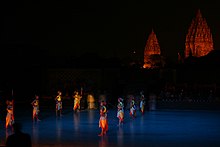



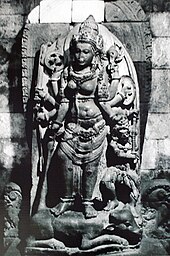

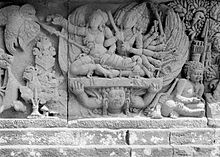

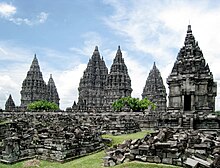

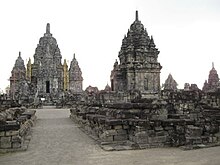

No comments:
Post a Comment
हिंदू हिंदी हिन्दुस्थान के पाठक और टिप्पणीकार के रुप में आपका स्वागत है! आपके सुझावों से हमें प्रोत्साहन मिलता है कृपया ध्यान रखें: अपनी राय देते समय किसी प्रकार के अभद्र शब्द, भाषा का प्रयॊग न करें।